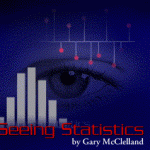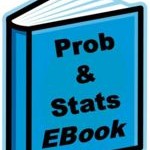HyperStat Online Statistics Textbook
Posted by Armando Brito Mendes | Filed under estatística, lições, materiais ensino
Mais um eBook com montes de links para outros recursos
RVLS Home | Glossary | Free Statistical Analysis Tools | Instructional Demos | Exercises and Problems | Statistics Help | Privacy policy
Contents
- Introduction to Statistics
- Describing Univariate Data
- Describing Bivariate Data
- Introduction to Probability (elementary)
- Normal Distribution
- Sampling Distributions
- Point Estimation
- Confidence Intervals
- The Logic of Hypothesis Testing
- Testing Hypotheses with Standard Errors
- Power
- Introduction to Between-Subjects ANOVA
- Factorial Between-Subjects ANOVA
- Within-Subjects/Repeated Measures ANOVA
- Prediction
- Chi Square
- Distribution-Free Tests
- Measuring Effect Size
© 1993-2013 David M. Lane
Tags: análise de dados, Estat Descritiva
Probability and statistics EBook
Posted by Armando Brito Mendes | Filed under estatística, lições, materiais ensino
Um bom ebook com boas animações
SOCR Books: This is a General Statistics Curriculum E-Book, which includes Advanced-Placement (AP) materials.
Contents
- 1 Preface
- 2 Chapter I: Introduction to Statistics
- 3 Chapter II: Describing, Exploring, and Comparing Data
- 4 Chapter III: Probability
- 5 Chapter IV: Probability Distributions
- 6 Chapter V: Normal Probability Distribution
- 7 Chapter VI: Relations Between Distributions
- 8 Chapter VII: Point and Interval Estimates
- 9 Chapter VIII: Hypothesis Testing
- 10 Chapter IX: Inferences From Two Samples
- 11 Chapter X: Correlation and Regression
- 12 Chapter XI: Analysis of Variance (ANOVA)
- 13 Chapter XII: Non-Parametric Inference
- 13.1 Differences of Medians (Centers) of Two Paired Samples
- 13.2 Differences of Medians (Centers) of Two Independent Samples
- 13.3 Differences of Proportions of Two Samples
- 13.4 Differences of Means of Several Independent Samples
- 13.5 Differences of Variances of Independent Samples (Variance Homogeneity)
- 14 Chapter XIII: Multinomial Experiments and Contingency Tables
- 15 Chapter XIV:Bayesian Statistics
- 16 Chapter XV: Other Common Continuous Distributions
- 16.1 Gamma Distribution
- 16.2 Exponential Distribution
- 16.3 Pareto Distribution
- 16.4 Beta Distribution
- 16.5 Laplace (Double Exponential) Distribution
- 16.6 Cauchy Distribution
- 16.7 Chi-Square Distribution
- 16.8 Fisher’s F Distribution
- 16.9 Johnson SB Distribution
- 16.10 Rice Distribution
- 16.11 Uniform Distribution
- 17 Additional EBook Chapters (under Development)
Tags: análise de dados, Estat Descritiva, inferência
Seeing Statistics
Posted by Armando Brito Mendes | Filed under estatística, lições, materiais ensino, visualização
 Uma excelente maneira de aprender estatística com um webBook dinâmico e muito visual
Uma excelente maneira de aprender estatística com um webBook dinâmico e muito visual
Seeing Statistics ® is a new approach to teaching statistics using the World Wide Web. This webbook is based on three premises:
- The important principles of statistics are remarkably easy if they can be seen.
- Active involvement of the student facilitates learning.
- Statistics can be fun!
Most of the graphs and figures in this textbook are dynamic and under the control of the reader. Interacting with the graphs allows you to see the important statistical principles in action.
Rather than talk about it, it is best to view Seeing Statistics in action. To access Seeing Statistics, click on the “Enter Seeing Statistics” button to begin your exploration of Seeing Statistics!
Table of Contents
0. Introduction

1. Data & Comparisons

2. Seeing Data

3. Describing the Center

4. Describing the Spread

5. Seeing Data, Again

6. Probability

7. Normal Distribution
7. Outline
![]()
7.0 Introduction
![]()
7.1 Origins of Normal
![]()
7.2 Size and Shape
![]()
7.3 Working with the Normal
![]()
7.4 Means have Normal Distributions
![]()
7.5 Evaluating Normality (optional)
![]()
7.6 Review
![]()
7.7 Exercises
![]()

8. Inference & Confidence

9. One-Sample Comparisons

10. Two-Sample Comparisons
Tags: análise de dados, Estat Descritiva, inferência
SurfStat
Posted by Armando Brito Mendes | Filed under estatística, lições, materiais ensino
Um bom livro on-line com apps e muito mais…
| SURFSTAT australia |
| This site has already benefited from the contributions of many people. Please do your bit and let us know of errors, missing topics or things you think could be better explained. |
Tags: análise de dados, Estat Descritiva
R and the Nobel Prize API
Posted by Armando Brito Mendes | Filed under estatística, software, visualização
Um bom exemplo do que se pode fazer com o R e uma API q serviços de dados.
he Nobel Prizes. Love them? Hate them? Are they still relevant, meaningful? Go on admit it, you always imagined you would win one day.
Whatever you think of them, the 2015 results are in. What’s more, the good people of the Nobel Foundation offer us free access to data via an API. I’ve published a document over at RPubs, showing some of the ways to access and analyse their data using R. Just to get you started:
Tags: análise de dados, belo, data mining, Estat Descritiva, R-software
The Statistics Portal
Posted by Armando Brito Mendes | Filed under estatística, materiais para profissionais, visualização
We pride ourselves in being one of the world’s first and only companies to bring together data from over 18,000 sources.
Our research analysts source the most up-to-date statistical data from around the globe; our analytical approach and efficient research processes enable us to supply our clients with the data that is relevant to them.
Tags: análise de dados, Estat Descritiva, software estatístico
Ternary Diagrams Using R
Posted by Armando Brito Mendes | Filed under estatística, materiais ensino, visualização
Exemplo de criação de diagramas ternários no R
Ternary Diagrams Using R: An Example Using Election Outcomes
A tutorial by D. M. Wiig
In part one of this tutorial I discussed creating a ternary diagram using a simple data frame that contained five hypothetical cases. In this tutorial I will expand on that foundation by creating a more informative ternary diagram using live data.
A useful application of this package in social science research is creating a visual display of parliamentary election outcomes. Specifically we can use a ternary graph to examine the distribution of seats in the British House of Commons over a period of time. Since the UK uses a proportional system to allocate seats in the House of Commons there can be a variety of outcomes in any given national election.
Tags: Estat Descritiva, R-software
Statistical Atlas
Posted by Armando Brito Mendes | Filed under estatística, mapas SIG's, materiais ensino, visualização
Um projeto em curso que pretende criar mapas temáticos de todos os dados existentes nos EUA, ambicioso, não?
Age and Sex
This is the age and biological sex of the population.
Disability
This is disability status.
Education
This is who goes to school.
Geology
This is the land and water.
Government
This is how the government functions.
Income and Earnings
This is how much money people make.
Language
This is how people communicate.
Living Arrangement
This is the household makeup.
Mortality
This is how people die.
Origins
This is where people come from.
Population
This is how many people there are.
Poverty
This is who lives below the poverty thresholds.
Transportation
This is how people get around.
Work
This is where and how people work.
Tags: belo, Estat Descritiva, mapas, R-software
Real Chart Rules to Follow
Posted by Armando Brito Mendes | Filed under estatística, materiais ensino, visualização
Excelente guia sobre construção de gráficos para representar dados.
There are a lot of “rules” for visualization. Some are actual rules, and some are suggestions to help you make choices. Many of the former can be broken, if that’s what the data dictates and you know what you’re doing.
But, there are rules—usually for specific chart types meant to be read in a specific way and with few exceptions—that you shouldn’t break. When they are, everyone loses. This is that small handful.
Tags: data mining, definição, Estat Descritiva, R-software
Comprehensive Guide to Data Visualization in R
Posted by Armando Brito Mendes | Filed under estatística, visualização
Bom resumo de alguns tipos de gráficos que podem ser obtidos no R, do mais simples a alguns mais complexos.
This visualization (originally created using Tableau) is a great example of how data visualization can help decision makers. Imagine telling this information to an investor through a table. How long do you think you will take to explain it to him?
With ever increasing volume of data in today’s world, it is impossible to tell stories without these visualizations. While there are dedicated tools like Tableau, QlikView and d3.js, nothing can replace a modeling / statistics tools with good visualization capability. It helps tremendously in doing any exploratory data analysis as well as feature engineering. This is where R offers incredible help.
R Programming offers a satisfactory set of inbuilt function and libraries (such as ggplot2, leaflet, lattice) to build visualizations and present data. In this article, I have covered the steps to create the common as well as advanced visualizations in R Programming.
Tags: análise de dados, data mining, Estat Descritiva, R-software, software estatístico







